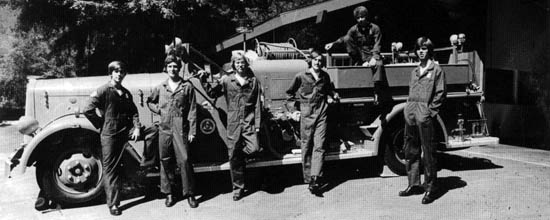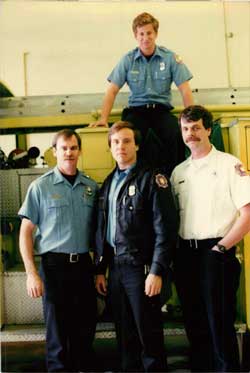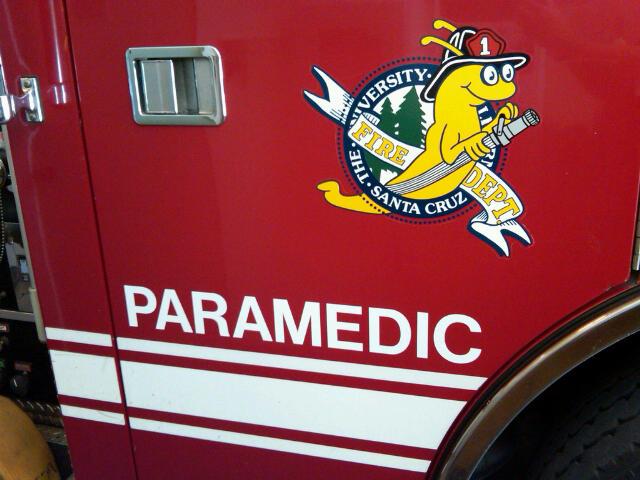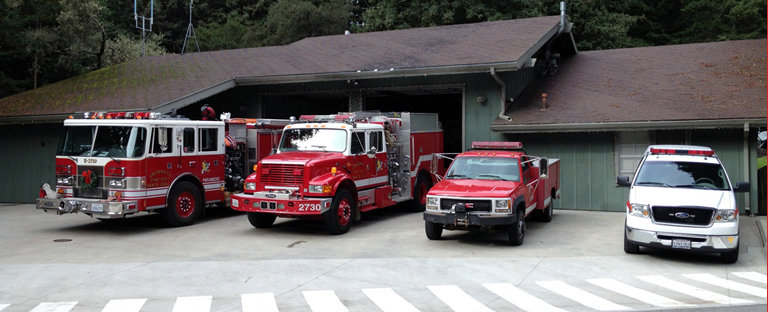History of the UCSC Fire Department
 When the campus first opened in 1964, fire protection and emergency response to the developed portions of the campus was provided by the Santa Cruz Fire Department operating from existing fire stations in the City of Santa Cruz, with the California Department of Forestry and Fire Protection (CAL FIRE) providing service to the upper campus. Fire prevention services on campus were provided by the first campus Fire Marshal, Frank Borges, and two Fire Inspectors.
When the campus first opened in 1964, fire protection and emergency response to the developed portions of the campus was provided by the Santa Cruz Fire Department operating from existing fire stations in the City of Santa Cruz, with the California Department of Forestry and Fire Protection (CAL FIRE) providing service to the upper campus. Fire prevention services on campus were provided by the first campus Fire Marshal, Frank Borges, and two Fire Inspectors. In April 1971, a fire occurred in the Central Services Building (now known as Hahn Student Services) which went undetected until it had grown to a very large size. As a result of this fire, the campus improved fire alarm systems throughout campus buildings. The fire also prompted the Regents to approve and fund the formation of a campus Fire Department at their October 1972 meeting in order to augment the City's response capabilities.
In April 1971, a fire occurred in the Central Services Building (now known as Hahn Student Services) which went undetected until it had grown to a very large size. As a result of this fire, the campus improved fire alarm systems throughout campus buildings. The fire also prompted the Regents to approve and fund the formation of a campus Fire Department at their October 1972 meeting in order to augment the City's response capabilities.Fire Marshal Frank Borges was designated as the first campus Fire Chief and initial staffing consisted of his position, two Captains (one as Fire Marshal and the other in charge of Training & Operations), three shift Lieutenants, four Engineers, and six student firefighters. The Fire Department initially operated out of the Stone House at the base of campus until completion of the campus fire station in February 1975.
Early campus fire apparatus included a 1953 Navy-surplus fire engine and a Dodge Power Wagon 4x4. The campus's first front-line engine was a 1976 Ford 8000-series Type 2 engine with a 750 GPM pump and a 600 gallon water tank identified as Engine 2720. The department also operated a pickup with a skid-mount pump identified as 2752 during this time, as well as several staff vehicles.
 The 1980s saw several major fires in campus buildings including Porter B Dorm and the destruction of Crown/Merrill Apartments Building 8 while under construction. In 1989, the Loma Prieta Earthquake struck with an epicenter less than 15 miles from campus and resulted in the Fire Department assuming increased emergency preparedness responsibilities for the campus.
The 1980s saw several major fires in campus buildings including Porter B Dorm and the destruction of Crown/Merrill Apartments Building 8 while under construction. In 1989, the Loma Prieta Earthquake struck with an epicenter less than 15 miles from campus and resulted in the Fire Department assuming increased emergency preparedness responsibilities for the campus.During this time, department ranks changed to be more in-line with other fire departments. The two Captain positions became Assistant Chiefs and the Lieutenant positions became Captains.
The student firefighter program was disbanded in December 1990 due to increased regulatory requirements and other financial issues and the Fire Department became an all-paid career department at this time. Staffing remained low throughout the 1990s with the two Assistant Chief positions remaining unfilled for most of the decade with a minimum of two personnel on duty for each shift.
The passage of the California Standardized Emergency Management Systems (SEMS) in 1993 saw the development of the first official campus Emergency Response Plan by the Fire Department and the establishment of the campus' first Emergency Operations Center (EOC) at the fire station. When needed, the apparatus would be pulled out of the apparatus bay, which would then be reconfigured into an EOC setup using equipment stored in an intermodal container behind the station.
The aging 1976 Ford Engine 2720 was replaced during the early 1990s with a surplus Van Pelt Type 1 engine from the Central Fire Protection District, which was redesignated as Engine 2710. This engine was replaced in 1998 with a brand new Pierce Saber Type 1 engine featuring all-steer, a feature which allowed the larger engine to more easily navigate the narrow fire lanes of campus.
The implementation of Cal/OSHA’s “two-in/two-out” regulation prompted the campus to increase staffing for the Fire Department and fill one of the vacant Assistant Chief positions. Shift staffing reached its highest level in 2003 with a Captain, an Engineer, and three Firefighters on each shift. Additionally, a second fire engine dedicated to wildland fire response in the upper campus was purchased in 2001. This engine, identified as Engine 2730, was built to the CAL FIRE Model 25 specificiation on an International 4900 chassis by Pierce and was cross-staffed as needed by the existing crew.
UC Santa Cruz was a founding member of the Santa Cruz County Hazardous Materials Interagency Team (SCHMIT) in 2001. Staff from both the Fire Department and Environmental Health and Safety provided both response and technical expertise to this county-wide hazardous materials team.
In January 2002, a 3rd alarm fire occurred in a lab in Sinsheimer Labs, requiring the combined resources of 15 engine companies, a truck company, and the SCHMIT to control. Damage from this fire was estimated at $6 million as well as extensive loss of research and led to the installation of a fire sprinkler system in Sinsheimer. When another fire occurred in the building in 2004, the sprinkler system quickly controlled the fire and prevented another catastrophic loss, demonstrating the value of such systems.
In 2003, the Fire Department participated in it’s first out-of-county wildland fire responses, sending engine companies as part of mutual aid strike teams to a wildland fires in Mendocino County and San Diego County. Following these fires, the Fire Department became part of the county’s mutual aid response capability and UCSC personnel assisted with many additional out-of-county responses over the next 10 years.
In 2007, the Fire Department created a new 40-hour Captain position to function as the campus Emergency Manager and expand the emergency preparedness program that had previously been 20% of the Assistant Fire Chief’s position. The Emergency Management program was further enhanced in 2009 with the hiring of a Business Continuity Planner as part of the systemwide UC Ready continuity planning initiative.
 In 2011, the Fire Department became an Advanced Life Support (ALS) agency staffing at least one Paramedic on each shift.
In 2011, the Fire Department became an Advanced Life Support (ALS) agency staffing at least one Paramedic on each shift. Beginning in January 2012, the UCSC Fire Department entered into a joint management contract with the Santa Cruz Fire Department. Following the retirement of the Santa Cruz Fire Chief Ron Oliver, UCSC Fire Chief Jeff Trapp assumed management for both agencies with other chief officer positions being shared between the city and campus as well. The 1998 Pierce Saber engine was also replaced with a 2012 Pierce Arrow XT built to the same specifications a two new city fire engines during this time for uniformity.
In 2013, the campus and the city entered into negotiations for the city to take over staffing of the campus fire station and all emergency response functions performed by the UCSC Fire Department.
Responsibility for staffing the campus fire station and units transferred to the Santa Cruz Fire Department on July 1, 2014 and the UCSC Fire Department was disbanded at that time. Fire Department shift personnel were hired by the City of Santa Cruz and became members of the Santa Cruz Fire Department during this transition. The campus fire station remains a university-owned building but was leased to the city and designated as SCFD Fire Station 4. The 2012 Engine 2710 and the 2001 Engine 2730 (along with two staff vehicles) were sold to the city and redesignated as Engine 3114 and Engine 3134 respectively. These engines are still housed at the campus fire station.
The UCSC Office of Emergency Services (OES) was also formed on July 1, 2014 under the Associate Vice Chancellor of Risk & Safety Services to house the campus fire marshal, emergency management, business continuity, public education, and mass notification (CruzAlert) functions formerly performed by the UCSC Fire Department, as well as to manage the fire services contract with the city. Campus Fire Marshal Rick Rodewald - who formerly served as the Assistant Chief - was transfered to OES in this role and a new Deputy Fire Marshal position was created to assist the Campus Fire Marshal and to take over the inspection activities previously performed by UCSC engine company personnel. Campus Emergency Manager Chris Gaylord was redesignated as the Director of Emergency Management and also transferred to OES along with Business Continuity Planner Rosemary Anderson to oversee the emergency management, business continuity, public education, and mass notification programs. The Director of Emergency Management is also responsible for the fire services contract and is the primary campus liaison to the Santa Cruz Fire Department.


